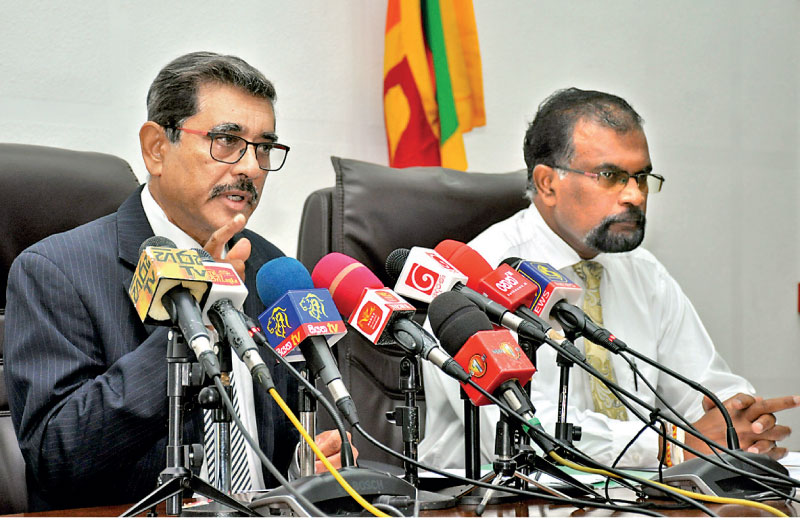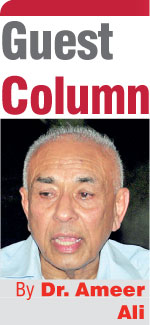Monday Apr 21, 2025
Monday Apr 21, 2025
Monday, 18 April 2022 00:25 - - {{hitsCtrl.values.hits}}

Central Bank Governor Dr. P. Nandalal Weerasinghe (left) with Treasury Secretary Mahinda Siriwardena last week at the media briefing on the suspension of repayment of all external debt as of 12 April - Pic by Lasantha Kumara
 In announcing the “pre-emptive negotiated” $ 51 billion debt default”, which in other words meant an official declaration of bankruptcy after notifying the creditors, CBSL Governor Dr. Nandalal Weerasinghe (NW) said, “We have lost the ability to repay foreign debt. It has come to a point that making debt payments are challenging and impossible. We need to focus on essential imports and not having to worry about servicing external debt”.
In announcing the “pre-emptive negotiated” $ 51 billion debt default”, which in other words meant an official declaration of bankruptcy after notifying the creditors, CBSL Governor Dr. Nandalal Weerasinghe (NW) said, “We have lost the ability to repay foreign debt. It has come to a point that making debt payments are challenging and impossible. We need to focus on essential imports and not having to worry about servicing external debt”.
Treasury Secretary Mahinda Siriwardena started the blame game by scapegoating, “recent events including COVID-19 pandemic and fall out from hostilities in Ukraine (for) eroding Sri Lanka’s fiscal position”.
But long before NW was imported to head CBSL to pick up the pieces from two years of destructive monetary and fiscal policies, both in support of an unrealistic vision of development rooted in the mind of a triumphalist and sectarian president, several economists and experienced central bankers warned him and his regime of the inevitability of bankruptcy unless those policies were reversed and IMF assistance sought immediately to restructure the country’s ballooning debt and financial difficulties. Their warnings fell on deaf ears.
Now that the inevitable had happened, the new Minister of Finance, a bosom buddy of the President, is playing a blame game. While the Treasury Secretary scapegoated the pandemic and Ukraine, the minister, in an interview with state-run Hiru TV, picked former Treasury Secretary Attygalle, former governor of CBSL Ajith Nivard Cabraal and former secretary to the President P.B. Jayasundara as the chief culprits who prevented seeking IMF assistance when, as he said, “almost all cabinet ministers were in favour of going”. The three “were talking about a home-grown solution instead”, he added.
The minister seems to be having short memories, because he had forgotten that soon after Professor Lakshman was appointed as CBSL Governor on 24 December 2019, President GR hurriedly called a meeting with the Monetary Board and instructed its members to assist implementing ‘his’ economic policies, or, vision to be more appropriate. After that meeting, he arbitrarily reconstituted that Board by removing a couple of members whom he thought would be obstacles and brought in ones who would be affirmative. Governor Lakshman himself rejected going to IMF and was talking about an alternate path to develop the economy. That path was GR’s path, and the so-called homegrown solutions were the rocks and pebbles laid out along that disastrous path. If at all one wants to blame someone it should be GR and his Viyathmaga cabal.
However, blaming anyone is pointless at the moment, because the reality of bankruptcy has begun to hurt and has to be confronted. Bankruptcy imposes a heavy burden on society, and that burden would be born disproportionately by the common people. The first international reaction came from Fitch, the reputed credit rating agency. It had downgraded the country’s largest commercial bank, Bank of Ceylon’s business profile score from b/negative to ccc/negative. That bank’s risk profile, asset quality score, and earning and profitability scores were also lowered accordingly. This downgrading would obviously have flow on effects on the strength and viability of other banks too. Leaving aside the technical details of this and other associated ratings to the care of financial experts and economists, what they imply in practice is further depreciation of the rupee. That would ultimately mean escalation in cost of living through higher import prices and retail prices at the bazaar.
CBSL’s tightened monetary policy would add further to rising prices. The economy has to produce and export more and more to import less and less. With ruling political instability whether this would be possible is doubtful. In the end, it is the ordinary folks who would be forced to carry the bulk of the burden caused by this bankruptcy, and to which they were not a party. This then was what NW meant when he said that the situation would get worse before getting better. The question is, how worse would it get and how long would it take to turn to the better.
Given this bleak prospect, IMF assistance would have to come with very stringent conditions. Whether the safety net that would be worked out between IMF and local negotiators is going to be sufficient to provide a minimum level of comfort to the suffering masses is yet to be seen. The Head of IMF has warned in the meantime that growth rates would fall throughout 2022 and 2023 in 143 economies that produce nearly 86% of the global GDP. With such pessimism a financially bankrupt country like Sri Lanka would need an honest government with pragmatic policies to manage the economy.
Can Sri Lankans expect that honesty and pragmatism from the current regime whose reckless economic management, dishonesty and wasteful expenditure proclivities produced the current situation in the first place? Nationwide public demonstrations that have become daily scenes are answering that question in the negative.
Thus, economic reparation demands political reparation to start with. This is the dilemma the country is facing now. Any compromising solution to be worked out between the current regime and opposition appears to be unacceptable to an awakened generation of young Sri Lankans whose number has bulged the country’s population pyramid in the middle. They have rejected the call for a dialogue by the Prime Minister and are prepared to occupy the streets and maidans until the regime gives up. Unless the political crisis is resolved economic reparation is a long way off.
(The writer is attached to the School of Business and Governance, Murdoch University, Western Australia.)
Discover Kapruka, the leading online shopping platform in Sri Lanka, where you can conveniently send Gifts and Flowers to your loved ones for any event including Valentine ’s Day. Explore a wide range of popular Shopping Categories on Kapruka, including Toys, Groceries, Electronics, Birthday Cakes, Fruits, Chocolates, Flower Bouquets, Clothing, Watches, Lingerie, Gift Sets and Jewellery. Also if you’re interested in selling with Kapruka, Partner Central by Kapruka is the best solution to start with. Moreover, through Kapruka Global Shop, you can also enjoy the convenience of purchasing products from renowned platforms like Amazon and eBay and have them delivered to Sri Lanka.
Discover Kapruka, the leading online shopping platform in Sri Lanka, where you can conveniently send Gifts and Flowers to your loved ones for any event including Valentine ’s Day. Explore a wide range of popular Shopping Categories on Kapruka, including Toys, Groceries, Electronics, Birthday Cakes, Fruits, Chocolates, Flower Bouquets, Clothing, Watches, Lingerie, Gift Sets and Jewellery. Also if you’re interested in selling with Kapruka, Partner Central by Kapruka is the best solution to start with. Moreover, through Kapruka Global Shop, you can also enjoy the convenience of purchasing products from renowned platforms like Amazon and eBay and have them delivered to Sri Lanka.